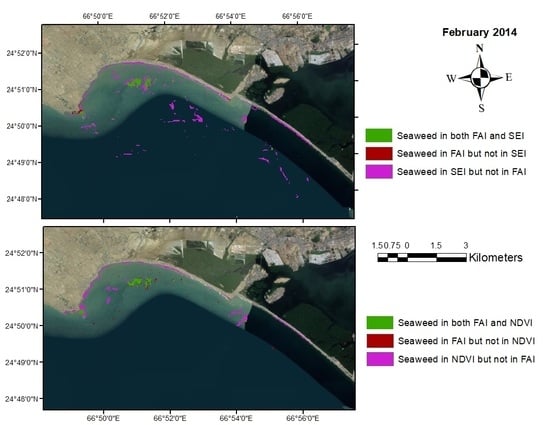Performance Evaluation of Newly Proposed Seaweed Enhancing Index (SEI)
Abstract
:1. Introduction
2. Material and Methods
2.1. Study Area and Satellite Data
2.2. Methodology
2.2.1. Pre Processing of Data
- Mp = band-specific multiplicative from metadata;
- Ap = additive rescaling factors from metadata;
- Qcal = quantized and calibrated standard product pixel values;
- θSE = sun elevation angle;
- θSZ = solar zenith angle computed by (90° − θSE);
- ρ′λ = TOA reflectance value with a correction (ρλ) for the sun angle was computed by equation 2 because ρ′λ does not contain the corrected sun angle.
2.2.2. Commonly Used Band Ratios—FAI and NDVI
- RrcNIR = baseline reflectance of NIR band.
- RrcNIR’ can be calculated using Equation (4).
- Rrc (Red) = baseline reflectance of the red band;
- Rrc (SWIR) = baseline reflectance of the shortwave infrared (SWIR) band;
- λNIR = wavelength of the NIR band;
- λRed = wavelength of the red band.
2.2.3. Spectral Signatures and Proposed Seaweed Index
2.2.4. Extraction of Seaweed Pixel
3. Results
3.1. Threshold Values for Seaweed Pixels
3.2. Seaweed Area Estimation
3.3. Validation of Seaweed Enhancing Index (SEI)
4. Discussion
5. Conclusions
- All three indices enhanced seaweed at the verified field collected GPS locations in all temporal images, which employed that the GPS points were at the permanent (seasonal) seaweed sites.
- Area estimation of seaweed resources of three indices showed variations. Overall, SEI extracted seaweed area was more than both NDVI and FAI, which was probably due to SEI capability of enhancing rocked attached patches and overestimation of rocked area. Another reason may be the possibility of SEI enhancing the submerged aquatic vegetation, which has low SWIR reflectance values [23]. However, this needs to be investigated, and if this reasoning happens to be correct, then it means that SEI works better in enhancing partially submerged seaweed patches, which other indices fail to do.
- NDVI and FAI failed to enhance rock attached seaweed pixels.
- The performance of SEI was found either better than or similar to NDVI based on percent seaweed area of FAI overlapped by the index.
Author Contributions
Funding
Acknowledgments
Conflicts of Interest
References
- Magg, W. Seaweed—Types of Seaweed; Te Ara-the Encyclopedia of New Zealand: Wellington, New Zealand, 2006.
- Haq, T.; Khan, F.A.; Begum, R.; Munshi, A.B. Bioconversion of drifted seaweed biomass into organic compost collected from the Karachi coast. Pak. J. Bot. 2011, 43, 3049–3051. [Google Scholar]
- Choi, C.G.; Takeuchi, Y.; Terawaki, T.; Serisawa, Y.; Ohno, M.; Sohn, C.H. Ecology of seaweed beds on two types of an artificial reef. J. Appl. Phycol. 2002, 14, 343–349. [Google Scholar] [CrossRef]
- Okuda, K. The Coastal Environment and Seaweed-Bed Ecology in Japan. Kuroshio Sci. 2008, 2, 15–20. [Google Scholar]
- Valderrama, D. Social and Economic Dimensions of Seaweed Farming: A Global Review. In Proceedings of the 16th International institute of fisheries economics and trade (IIFET), Dar es Salaam, Tanzania, 16–20 July 2012. [Google Scholar]
- Capuzzo, E.; McKie, T. Seaweed in the UK and Abroad—Status, Products, Limitations, Gaps, and Cefas Role; Centre for Environment, Fisheries & Aquaculture Science (Cefas): Suffolk, UK, 2016.
- Samee, H.; Li, Z.X.; Lin, H.; Khalid, J.; Guo, Y.C. Anti-allergic effects of ethanol extract from brown seaweeds. J. Zhejiang Univ. Sci. B 2009, 10, 147–153. [Google Scholar] [CrossRef] [PubMed]
- Pickrill, R.A.; Kostylev, V.E. Habitat Mapping and National Seafloor Mapping Strategies in Canada. Geol. Assoc. Canada 2007, 47, 449–462. [Google Scholar]
- Eakin, C.M.; Nim, C.J.; Brainard, R.E.; Aubrecht, C.; Elvidge, C.; Gledhill, D.K.; Muller-Karger, F.; Mumby, P.J.; Skirving, W.J.; Strong, A.E.; et al. Monitoring coral reefs from space. Oceanography 2010, 23, 118–133. [Google Scholar] [CrossRef]
- Hyun, J.C.; Deepak, M.; John, W. Remote Sensing of Submerged Aquatic Vegetation. In Remote Sensing—Applications; IntechOpen: London, UK, 2012. [Google Scholar] [Green Version]
- He, M.X.; Liu, J.; Yu, F.; Li, D.; Hu, C. Monitoring green tides in Chinese marginal seas. In Handbook of Satellite Remote Sensing Image Interpretation: Applications for Marine Living resources conservation and management; Morales, J., Stuart, V., Platt, T., Sathyendranath, S., Eds.; EU PRESPO and IOCCG: Dartmouth, NS, Canada, 2011; pp. 111–124. [Google Scholar]
- Gower, J.; Hu, C.; Borstad, G.; King, S. Ocean color satellites show extensive lines of floating Sargassum in the Gulf of Mexico. IEEE Trans. Geosci. Remote Sens. 2006, 44, 3619–3625. [Google Scholar] [CrossRef]
- Gower, J.; King, S.; Goncalves, P. Global monitoring of plankton blooms using MERIS MCI. Int. J. Remote Sens. 2008, 29, 6209–6216. [Google Scholar] [CrossRef]
- Ko, B.; Kim, H.; Nam, J. Classification of potential water bodies using Landsat 8 OLI and a combination of two boosted random forest classifiers. Sensors 2015, 15, 13763–13777. [Google Scholar] [CrossRef] [PubMed]
- Hu, C. A novel ocean color index to detect floating algae in the global oceans. Remote Sens. Environ. 2009, 113, 2118–2129. [Google Scholar] [CrossRef]
- Hu, C.; He, M. Origin and offshore extent of floating algae in Olympic sailing area. Eos Trans. Am. Geophys. Union 2008, 89, 302. [Google Scholar] [CrossRef]
- El-Alem, A.; Chokmani, K.; Laurion, I.; El-Adlouni, S.E. Comparative analysis of four models to estimate chlorophyll-a concentration in case-2 waters using MODerate resolution imaging spectroradiometer (MODIS) imagery. Remote Sens. 2012, 4, 2373–2400. [Google Scholar] [CrossRef]
- Campbell, J.B.; Wynne, R.H. Introduction to Remote Sensing; Guilford Press: New York, NY, USA, 2011. [Google Scholar]
- Cho, H.J.; Lu, D. A water-depth correction algorithm for submerged vegetation spectra. Remote Sens. Lett. 2010, 1, 29–35. [Google Scholar] [CrossRef]
- Lubin, D.; Li, W.; Dustan, P.; Mazel, C.H.; Stamnes, K. Spectral signatures of coral reefs: Features from space. Remote Sens. Environ. 2001, 75, 127–137. [Google Scholar] [CrossRef]
- Ali, A.; Malik, S.; Zaidi, A.Z.; Ahmad, N.; Shafique, S.; Aftab, M.N.; Aisha, K. Standing Stock Of Seaweeds In Submerged Habitats Along The Karachi Coast, Pakistan: An Alternative Source Of Livelihood For Coastal Communities. Pak. J. Bot. 2019, 51, 5. [Google Scholar] [CrossRef]
- Dierssen, H.M.; Zimmerman, R.C.; Bissett, P.J. The Red Edge: Exploring high near-infrared reflectance of phytoplankton and submerged macrophytes and implications for aquatic remote sensing. In AGU Spring Meeting Abstracts; American Geophysical Union (AGU): Washington, DC, USA, 2007. [Google Scholar]
- Hestir, E.L. Trends in Estuarine Water Quality and Submerged Aquatic Vegetation Invasion; University of California: Davis, CA, USA, 2010. [Google Scholar]

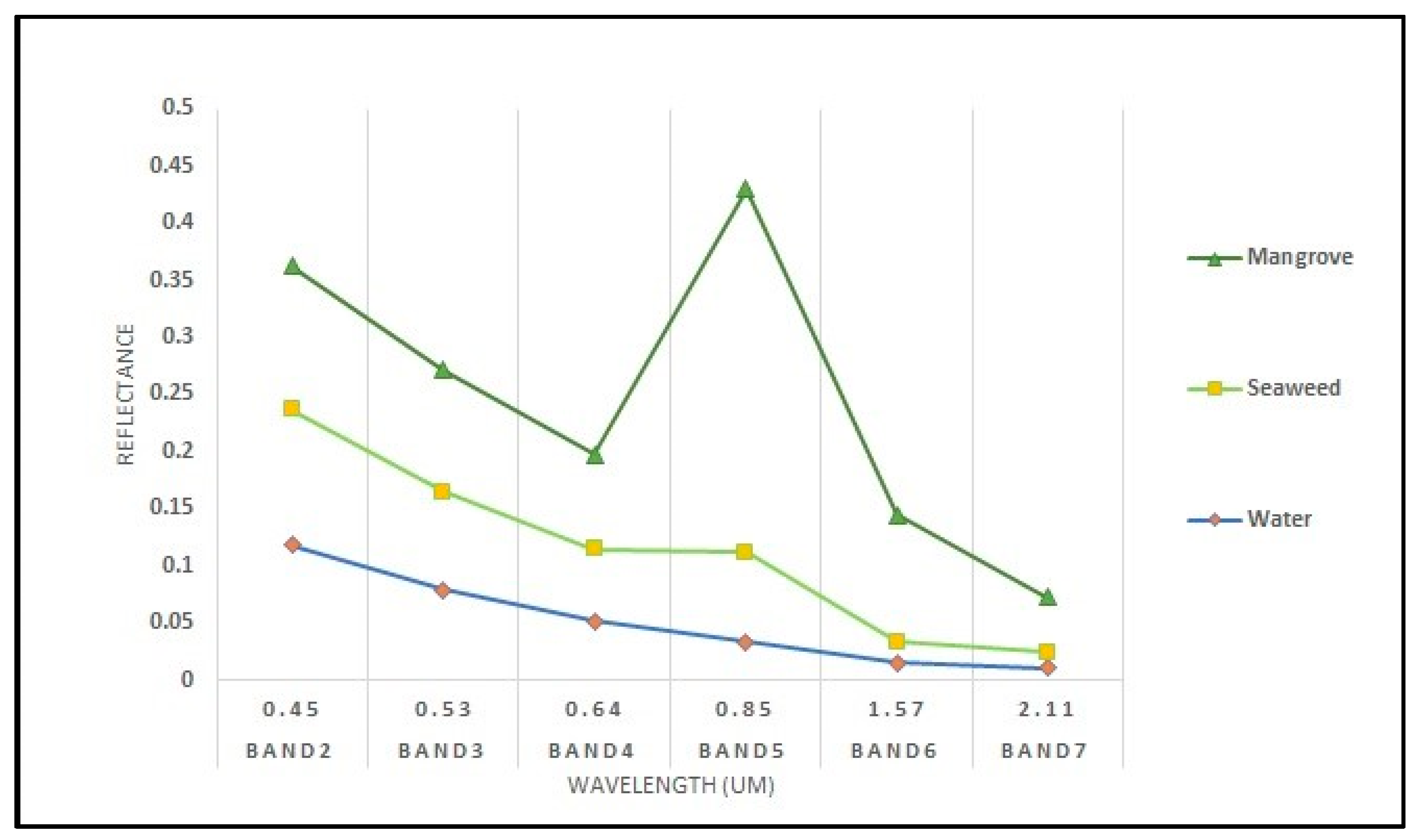
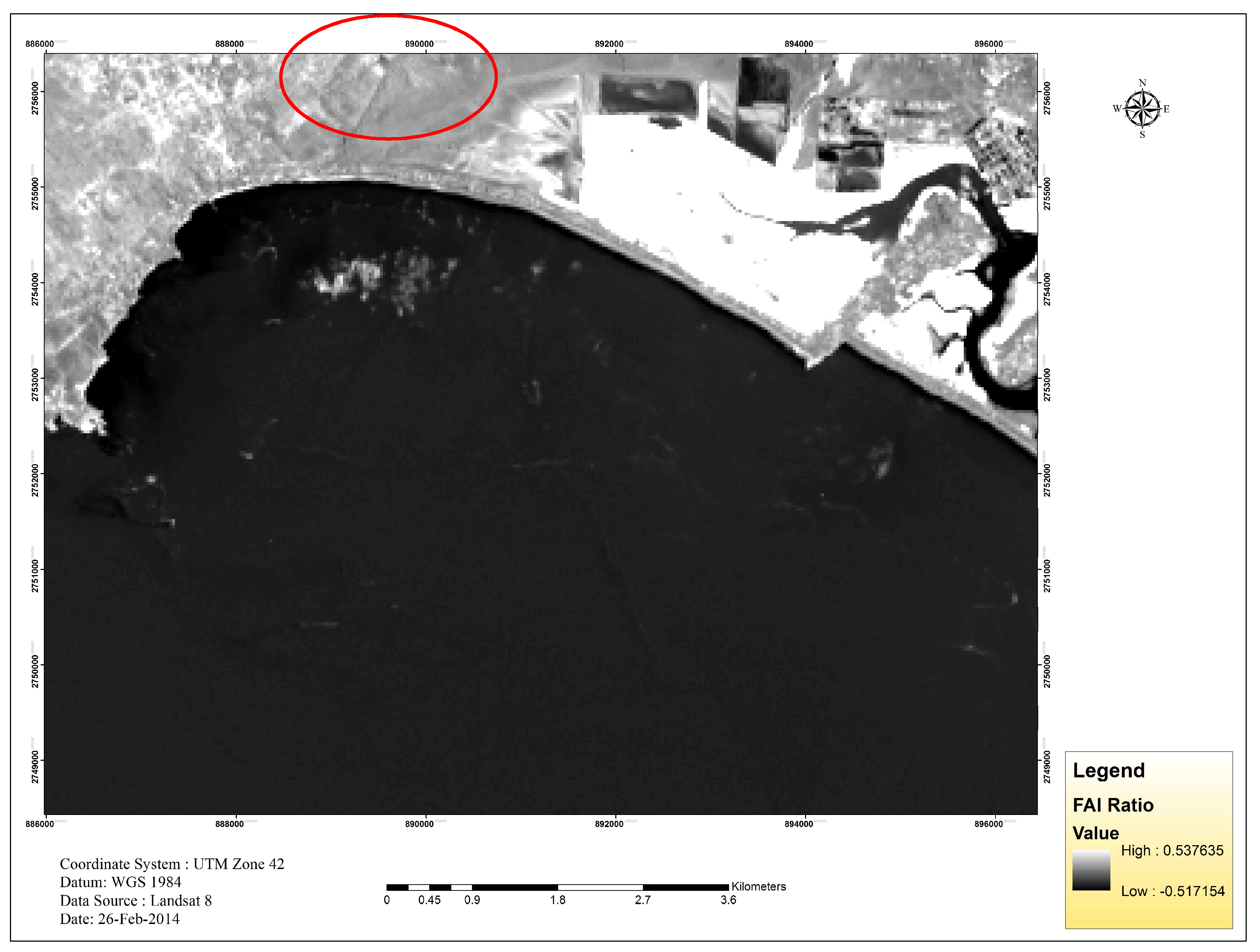

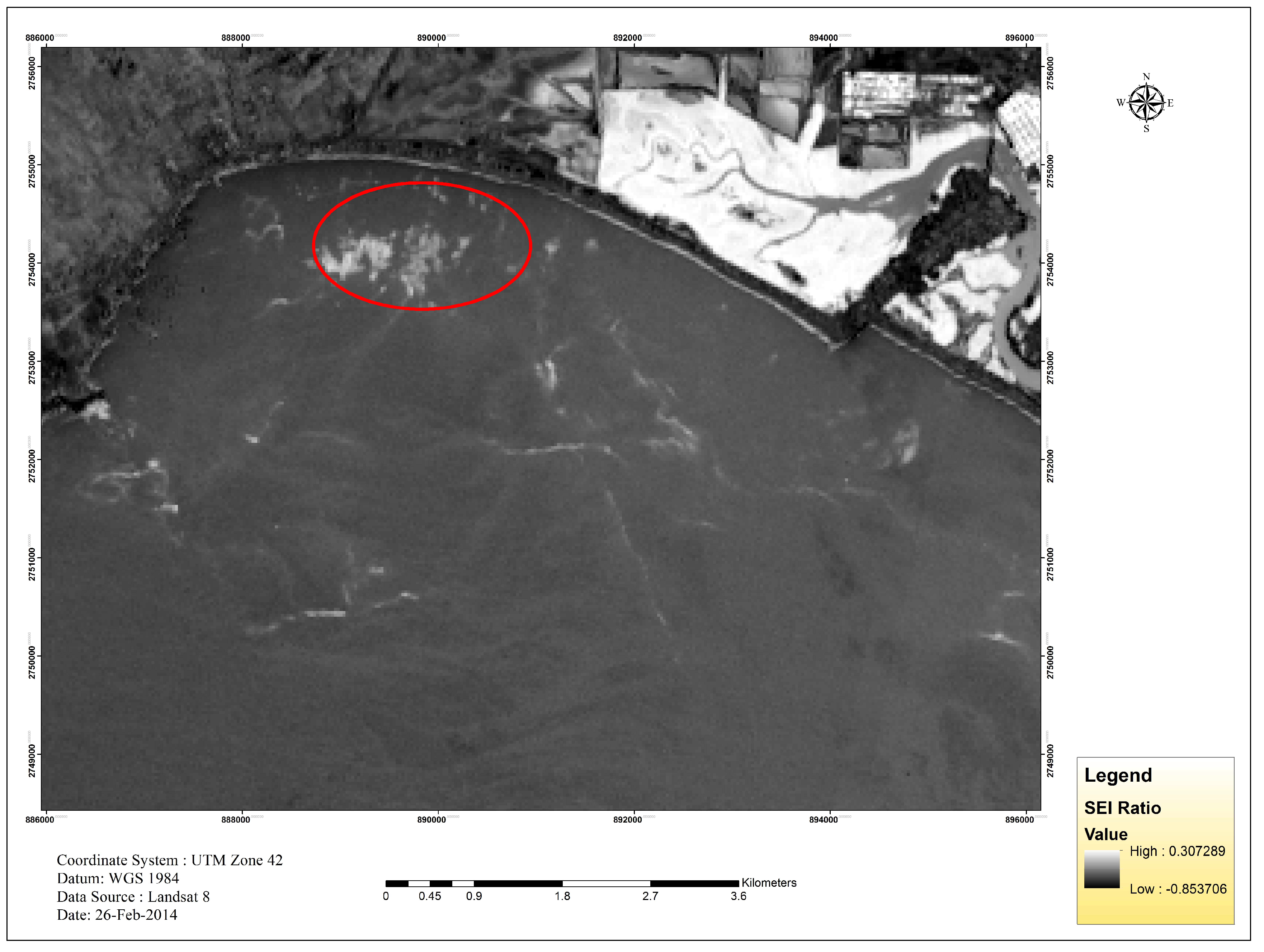

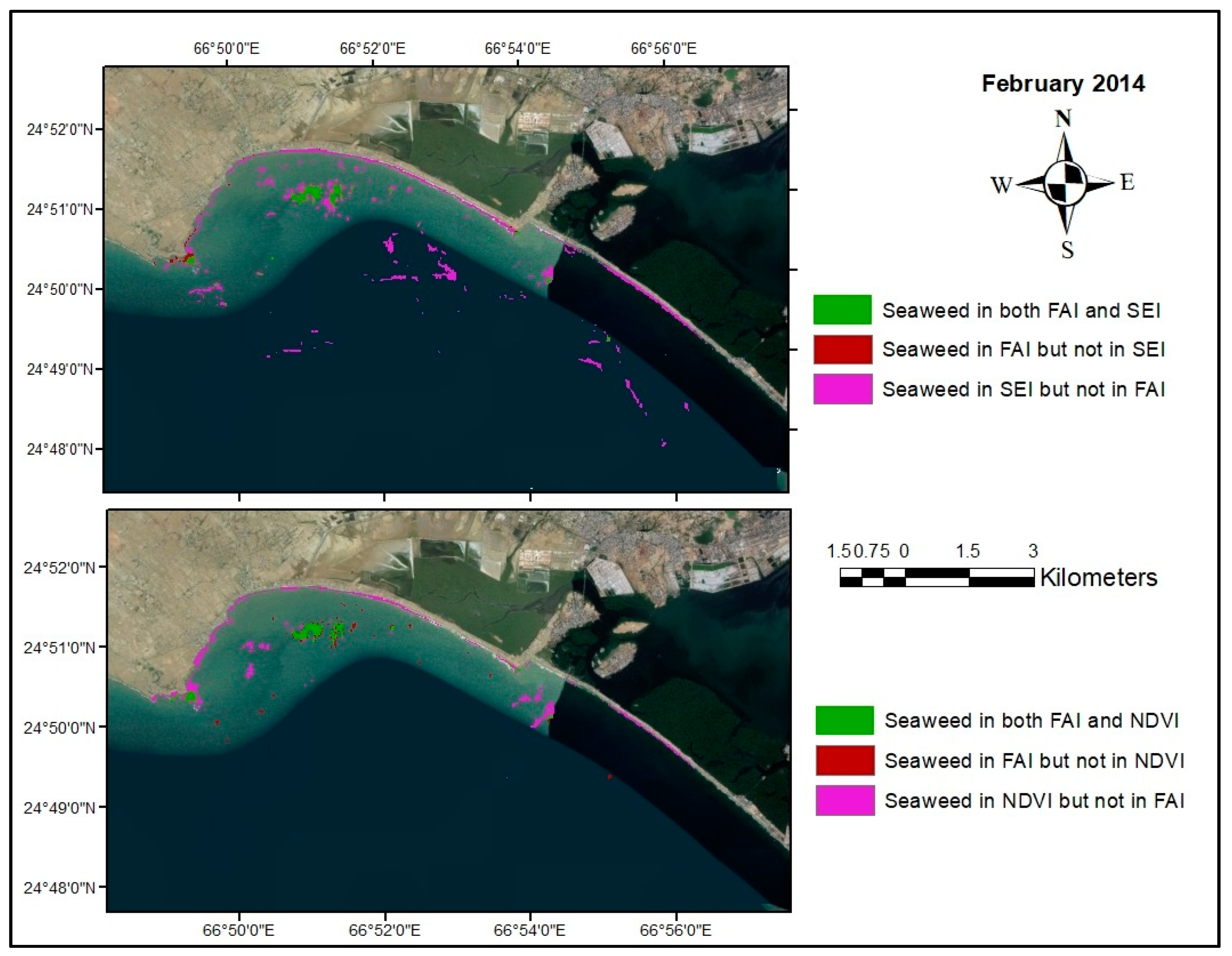
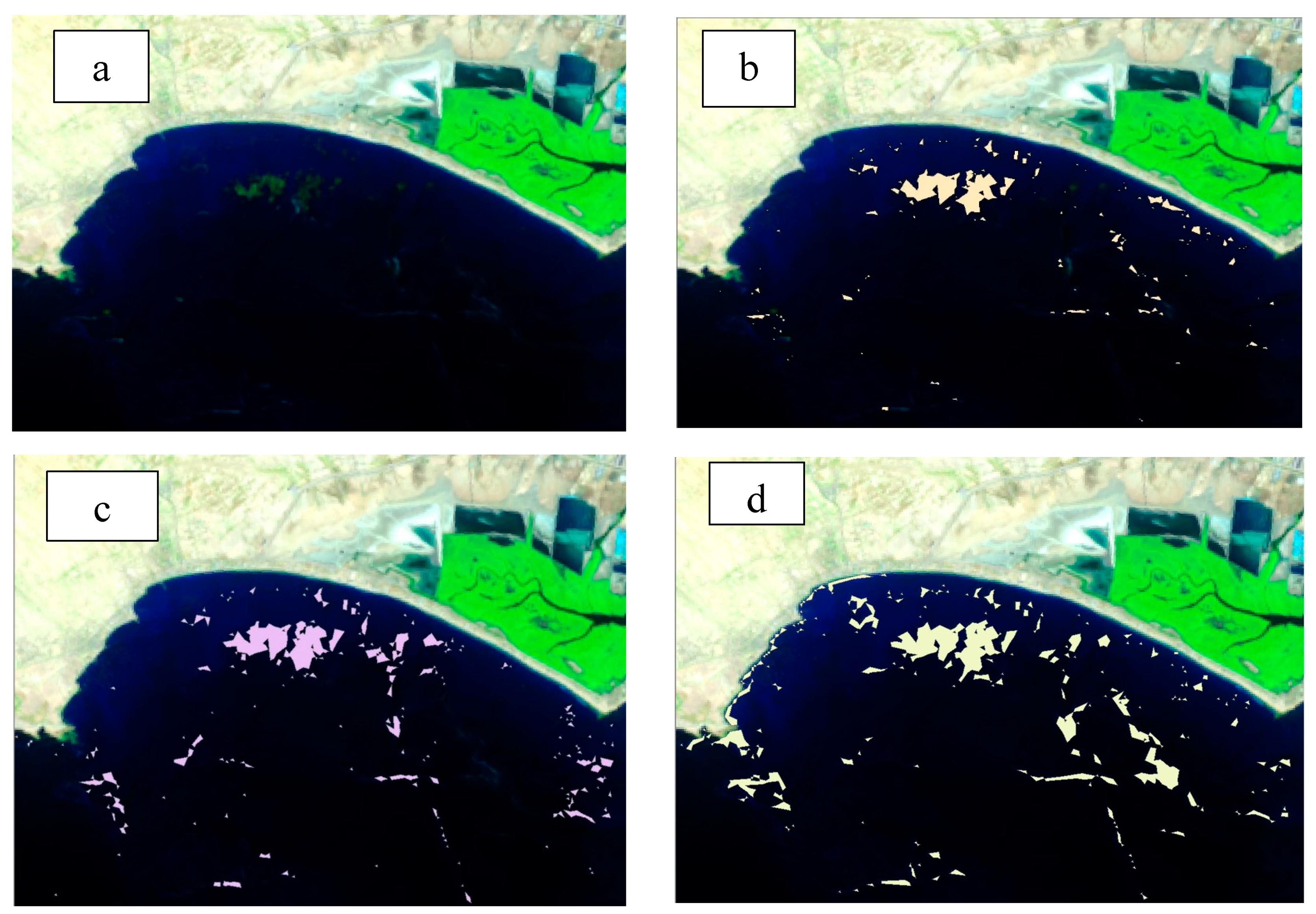
| Class | Pixel Value Range |
|---|---|
| Water | −0.510 to −0.008 |
| Seaweed | 0.008 to 0.130 |
| Mangrove | 0.130 to 0.530 |
| Class | Pixel Value Range |
|---|---|
| Water | −0.145 to −0.044 |
| Seaweed | −0.044 to 0.121 |
| Mangrove | 0.159 to 0.372 |
| Class | Pixel Value Range |
|---|---|
| Water | −0.85 to 0.08 |
| Seaweed | 0.08 to 0.24 |
| Mangrove | 0.24 to 0.307 |
| Landsat 8 Image Date and Month | Indices | Area Estimation (km2) |
|---|---|---|
| 25 January 2014 | NDVI | 1.78 |
| FAI | 1.91 | |
| SEI | 1.93 | |
| 19 February 2014 | NDVI | 0.98 |
| FAI | 1.97 | |
| SEI | 2.1 | |
| 7 March 2014 | NDVI | 0.594 |
| FAI | 0.75 | |
| SEI | 0.79 | |
| 24 January 2016 | NDVI | 0.59 |
| FAI | 0.63 | |
| SEI | 0.65 | |
| 9 February 2016 | NDVI | 0.7 |
| FAI | 1.1 | |
| SEI | 1.54 | |
| 3 March 2016 | NDVI | 0.908 |
| FAI | 1.8 | |
| SEI | 1.95 | |
| 21 February 2018 | NDVI | 0.30 |
| FAI | 0.34 | |
| SEI | 0.42 | |
| 9 March 2018 | NDVI | 0.190 |
| FAI | 0.32 | |
| SEI | 0.43 |
| For NDVI | For SEI | For NDVI | For SEI | ||
|---|---|---|---|---|---|
| Jan 2014 | March 2016 | ||||
| A | 1.3932 | 1.2294 | A | 0.387 | 0.4077 |
| B | 0.2583 | 0.4212 | B | 0.2475 | 0.2268 |
| C | 0.0027 | 0.6498 | C | 0.0009 | 0.7659 |
| Feb 2014 | Jan 2018 | ||||
| A | 0.3501 | 0.4122 | A | 2.7045 | 4.0689 |
| B | 0.1125 | 0.0504 | B | 1.4148 | 0.0504 |
| C | 0.7821 | 1.5129 | C | 0.4122 | 5.1174 |
| March 2014 | Feb 2018 | ||||
| A | 0.4743 | 0.3942 | A | 0.522 | 0.1161 |
| B | 0.0585 | 0.1386 | B | 0.0108 | 0.4167 |
| C | 0.666 | 0.7821 | C | 0.0594 | 0.3519 |
| Jan 2016 | March 2018 | ||||
| A | 0.2421 | 0.081 | A | 0.5076 | 0.0765 |
| B | 0 | 0.1611 | B | 0.0252 | 0.4563 |
| C | 2.8197 | 0.1188 | C | 0.0081 | 0.1188 |
| Feb 2016 | |||||
| A | 0.4374 | 0.612 | Seaweed in both FAI and SEI/NDVI | A | |
| B | 0.2232 | 0.0486 | Seaweed in FAI but not in SEI/NDVI | B | |
| C | 0.1593 | 0.1602 | Seaweed in SEI/NDVI but not in FAI | C | |
| Image Date | Jan-14 | Jan-16 | Jan-18 | Feb-14 | Feb-16 | Feb-18 | Mar-14 | Mar-16 | Mar-18 |
|---|---|---|---|---|---|---|---|---|---|
| Total seaweed area in FAI (km2) | 1.6515 | 0.2421 | 4.1193 | 0.4626 | 0.6606 | 0.5328 | 0.5328 | 0.6345 | 0.5328 |
| NDVI (%) | 84.36 | 100.00 | 65.65 | 75.68 | 66.21 | 97.97 | 89.02 | 60.99 | 95.27 |
| SEI (%) | 74.48 | 33.46 | 98.78 | 89.11 | 92.64 | 21.79 | 73.99 | 64.26 | 14.36 |
© 2019 by the authors. Licensee MDPI, Basel, Switzerland. This article is an open access article distributed under the terms and conditions of the Creative Commons Attribution (CC BY) license (http://creativecommons.org/licenses/by/4.0/).
Share and Cite
Siddiqui, M.D.; Zaidi, A.Z.; Abdullah, M. Performance Evaluation of Newly Proposed Seaweed Enhancing Index (SEI). Remote Sens. 2019, 11, 1434. https://doi.org/10.3390/rs11121434
Siddiqui MD, Zaidi AZ, Abdullah M. Performance Evaluation of Newly Proposed Seaweed Enhancing Index (SEI). Remote Sensing. 2019; 11(12):1434. https://doi.org/10.3390/rs11121434
Chicago/Turabian StyleSiddiqui, Muhammad Danish, Arjumand Z. Zaidi, and Muhammad Abdullah. 2019. "Performance Evaluation of Newly Proposed Seaweed Enhancing Index (SEI)" Remote Sensing 11, no. 12: 1434. https://doi.org/10.3390/rs11121434




